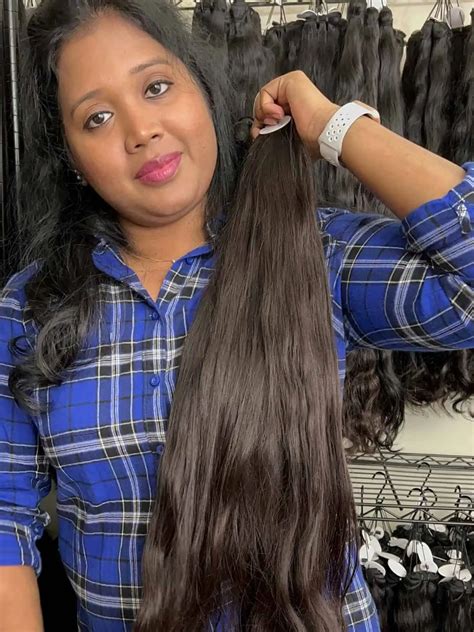Introduction
Raw Indian hair is a luxurious and sought-after commodity in the hair industry, renowned for its exceptional quality, versatility, and natural beauty. Its origins lie in the pristine temples of India, where it is meticulously collected from temple donors. If you’re considering investing in raw Indian hair, here are five essential tips to guide your decision-making:

1. Authenticity and Ethical Sourcing
- Ensure that the hair is genuinely raw, unprocessed, and sourced ethically.
- Look for certifications from reputable organizations such as the Indian Hair Extension Association (IHEA) or the Good Housekeeping Seal.
- Inquire about the temple where the hair was donated and verify its authenticity.
2. Type and Texture
- Indian hair comes in various textures, including straight, wavy, curly, and coily.
- Determine your desired texture and match it with the specific type of raw Indian hair available.
- Consider the natural wave pattern and porosity of the hair before making a selection.
3. Grade and Quality
- Raw Indian hair is graded based on its quality, ranging from single drawn to double drawn.
- Single drawn hair has a mix of short and long strands, while double drawn hair consists primarily of longer strands.
- Higher grades command a premium price but offer a more consistent and luxurious look.
4. Color and Customization
- Raw Indian hair is naturally dark brown or black but can be colored or lightened to achieve your desired shade.
- Consult with a professional colourist to determine the appropriate coloring techniques.
- Extensions can be customized to match your natural hair color or create a bold, new look.
5. Maintenance and Care
- Treat raw Indian hair with care to maintain its longevity and beauty.
- Use sulfate-free shampoos and conditioners specially formulated for extensions.
- Avoid excessive heat styling and use a heat protectant spray.
- Regular trims are recommended to remove split ends and ensure healthy growth.
Additional Tips
- Purchase hair from reputable vendors with a proven track record of quality and customer satisfaction.
- Read reviews and testimonials from previous clients to gain insights into the vendor’s services.
- Be prepared to pay a premium price for high-quality raw Indian hair.
- Invest in professional installation and maintenance to ensure optimal results.
Why Choose Raw Indian Hair?
Raw Indian hair offers exceptional benefits that set it apart from other hair types:
- Natural Beauty: Its virgin, unprocessed nature preserves its natural shine, body, and texture.
- Durability: With proper care, raw Indian hair can last for several years, making it a worthwhile investment.
- Versatility: Can be styled in endless ways, from sleek straight looks to voluminous curls.
- Health: Chemical-free and gentle on your scalp, promoting hair growth and overall scalp health.
- Confidence: Enhances your appearance and boosts your self-esteem.
Table 1: Raw Indian Hair Grades
| Grade | Description |
|---|---|
| Single Drawn | Contains a mix of short and long strands |
| Double Drawn | Mostly long strands, creating a thicker, fuller look |
| Super Double Drawn | Exclusively long strands, resulting in a seamless, luxurious appearance |
Table 2: Raw Indian Hair Textures
| Texture | Natural Wave Pattern |
|---|---|
| Straight | Minimal to no wave |
| Wavy | Loose, effortless waves |
| Curly | Defined, bouncy curls |
| Coily | Tight, springy curls |
Table 3: Raw Indian Hair Color Range
| Color | Description |
|---|---|
| Natural Black | Deep, rich black |
| Natural Brown | Chocolatey brown with subtle variations |
| #1B | Off-black with a slightly brown tint |
| #2 | Dark brown with hints of warm tones |
| #3 | Medium brown with a neutral undertone |
Table 4: Hair Care Tips for Raw Indian Hair
| Tip | Benefits |
|---|---|
| Sulfate-Free Shampoo | Cleanses gently without stripping natural oils |
| Leave-In Conditioner | Moisturizes and detangles |
| Heat Protectant Spray | Prevents damage from heat styling |
| Regular Trims | Removes split ends and promotes healthy growth |
Effective Strategies for Maintaining Raw Indian Hair
- Wash and condition hair regularly, but avoid over-washing.
- Use a wide-tooth comb or paddle brush to detangle wet hair.
- Avoid brushing dry hair as it can cause breakage.
- Protect hair from sun exposure by wearing a hat or scarf.
- Get regular trims every 6-8 weeks.
Common Mistakes to Avoid
- Over-processing the hair with chemicals or heat.
- Using harsh shampoos or conditioners.
- Brushing hair when it’s dry.
- Sleeping with wet hair.
- Over-tightening extensions.
FAQs
1. How long does raw Indian hair last?
With proper care, raw Indian hair can last for several years.
2. Can raw Indian hair be colored or lightened?
Yes, it can be colored or lightened but should be done by a professional colourist.
3. How often should I wash raw Indian hair?
Wash raw Indian hair 1-2 times per week, depending on your hair type and styling habits.
4. Can I style raw Indian hair with heat tools?
Yes, but use a heat protectant spray and avoid excessively high temperatures.
5. How much does raw Indian hair cost?
Prices vary depending on length, grade, and vendor. Expect to pay a premium for high-quality hair.
6. How do I find a reputable vendor?
Read reviews and testimonials, check certifications, and consider referrals from professionals.
7. What’s the difference between raw Indian hair and virgin hair?
Raw Indian hair is unprocessed, while virgin hair may have undergone minimal processing such as washing and conditioning.
8. Can I wear raw Indian hair in braids or locs?
Yes, raw Indian hair is suitable for various protective styles, including braids, locs, and weaves.
